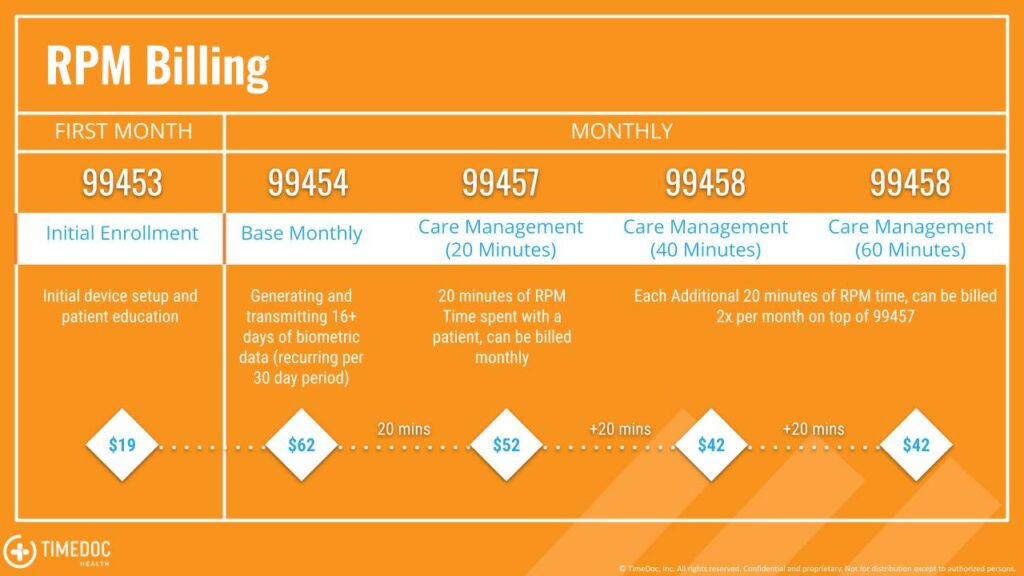What is a CPT Code?
Current Procedural Terminology (CPT codes) are numbers assigned to every task and service a provider administers to a patient, including medical, surgical, and diagnostic services. Insurers use these codes to determine the amount of reimbursement that a practitioner will receive from an insurer for that service.
What is a reimbursement?
Healthcare reimbursement describes the payment that your hospital, doctor, diagnostic facility, or other healthcare providers receive for giving you a medical service.
Asynchronous Care
Asynchronous care is a “term describing store-and-forward transmission of medical images and/ or data because the data transfer takes place over a period of time, and typically in separate time frames. The transmission typically does not take place simultaneously,” according to americantelemed.org. Remote Patient Monitoring (RPM) is a form of asynchronous care that many providers rely on to help patients manage and improve their conditions.
Remote Patient Monitoring (RPM)
Remote patient monitoring (RPM) uses asynchronous care by allowing patients to use connected devices to submit vital health metrics directly to their provider team outside of the healthcare setting. When RPM is done properly, patient submitted vitals are populated directly into the patient chart where clinical team members can review for clinical decision making.
The main CPT Codes that are used for RPM are 99453, 99454, 99457, 99458.
RPM CPT Code
The Centers for Medicare & Medicaid Services (CMS) have established CPT codes for remote patient monitoring (RPM). RPM tracks patient vitals outside of the healthcare setting to allow providers to intervene and improve health outcomes.
RPM CPT Code: 99453
RPM CPT Code: 99453 handles remote monitoring of physiologic parameters, including weight, blood pressure, pulse oximetry, respiratory flow rate. This code represents the initial setup and patient education on how to use connected devices as well as best practices on when to take measurements. CPT code 99453 is a one-time billing code that is used when a patient initially enrolls into a remote monitoring program at the recommendation of a physician or qualified healthcare professional (QHP). CPT Code: 99453 averages about $19.00 when billable.
RPM CPT Code: 99454
RPM CPT Code: 99454 is used for the monthly remote monitoring of the physiological parameters and covers the supply and provisioning of the device that the patient is using. Again, the device must be ordered by a physician or QHP. CPT Code: 99454 is billable every 30 days and covers the cost a provider incurs if they lease or purchase the device for their patient. In 2021, CMS provided clarification that this code requires the patient to submit at least 16 days of device readings during the 30-day period. The standard reimbursement for CPT Code: 99454 regardless of the cost of devices, is $62.00 for technologies provided under this code.
RPM CPT Code: 99457
RPM CPT Code: 99454 is used for the care management and coordination. This monthly billing code for RPM patients requires 20 minutes of interactive virtual care during the calendar month that a qualified healthcare provider or care manager gives to the patient. This code is billable once a month regardless of the RPM patient’s conditions. On average the reimbursement for this code is $52.00.
RPM CPT Code: 99458
RPM CPT Code: 99458 is also a part of the interactive virtual care during the calendar month. However, this code is for additional time spent with the patient. Healthcare organizations can additionally bill in 20-minute increments using this code after they meet the requirements for code 99457. For example, if a patient gets 40 minutes of virtual care covered by RPM, this code will be used to bill for the incremental 20 minutes. On average, the reimbursement for the code will be $42.00.

Reimbursement for RPM CPT codes can vary but the national averages are as follows:
RPM CPT Code: 99453: $19.00
RPM CPT Code: 99454: $62.00
RPM CPT Code: 99457: $52.00
RPM CPT Code: 99458: $42.00
In the first month of RPM, if a patient has initial setup, submits at least 16 days of readings, and receives the first 20 minutes of care, the monthly reimbursement average will be $144. Average reimbursement would increase by $43 for each additional 20 minutes of care provided.
After the first month of care, if a patient submits at least 16 days of readings and receives the initial 20 minutes of care, the monthly reimbursement average will be $123. Average reimbursement would increase $43 for each additional 20 minutes of care provided.
Sources:
https://www.foley.com/en/insights/publications/2020/12/2021-remote-patient-monitoring-cms-final-rule#:~:text=RPM%20involves%20the%20collection%20and,99454%2C%2099457%2C%20and%2099458http://www.pyapc.com/wp-content/uploads/2019/10/Providing-and-Billing-Medicare-for-Remote-Patient-Monitoring-PYA.pdf
https://www.healthrecoverysolutions.com/hubfs/Reimbursement%20Webinar/2020%20CPT%20Billing%20Guide.pdf
https://timedochealth.com/remote-patient-monitoring/
https://validic.com/your-guide-to-reimbursement-for-remote-patient-monitoring/#:~:text=CPT%20Code%2099453%20allows%20for,the%2030%2Dday%20billing%20period
https://www.americantelemed.org/resource/why-telemedicine/

